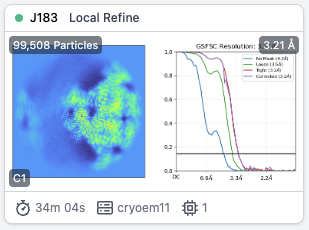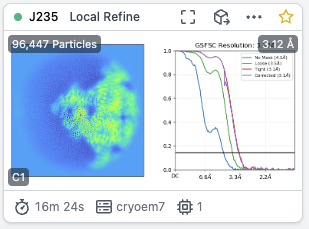Hi @olibclarke,
Please see responses below:
A. Yes, VAT will only change the particles alignments3D/shift and alignments3D/pose. Apply Trajs relies on locations/center(x/y)_frac and this is only updated when extracting with re-centering enabled. If you do not re-center, you might see signal folding and a poorer reconstruction, see below. J183 had no re-extraction and J235 had re-extraction post-VAT.


B. Yeah, this was my callback to my earlier comment about this not being streamlined. I have documented all of the intricacies of this workflow internally.
C: The plots that are made at the start of the job visualize the connected empirical dose weights. Specifically, the first plot shows the dose weights in 1 frequency dimension, just like how the reference motion job does. The next three plots are 2D Fourier space visualization of the dose weights at the first frame, the middle frame, and the last frame. Sorry for the lack of explanation in the job itself, that job was originally an internal debugging tool that got released in case it helped for cases like this. We aim to improve information related to this job in the future.
D: Yes, failed movies can be reprocessed later. The reason some movies are failing but not others is probably due to particle count per micrograph - the highest particle counts will have the highest memory footprint. You could verify that is what’s going on by having a look at the successful and failed ones in exposure curation.
E. The error when using the parameter appears to be a bug, you would need to use exposure sets tools or curate exposures to subset the mics and provide those as inputs.
F. Experimental dose weights are box size dependent. If you want to downsample at this stage you can still use Apply Trajectories (via the standard dose weight model) but you have to disconnect the empirical dose weights in order to do that.